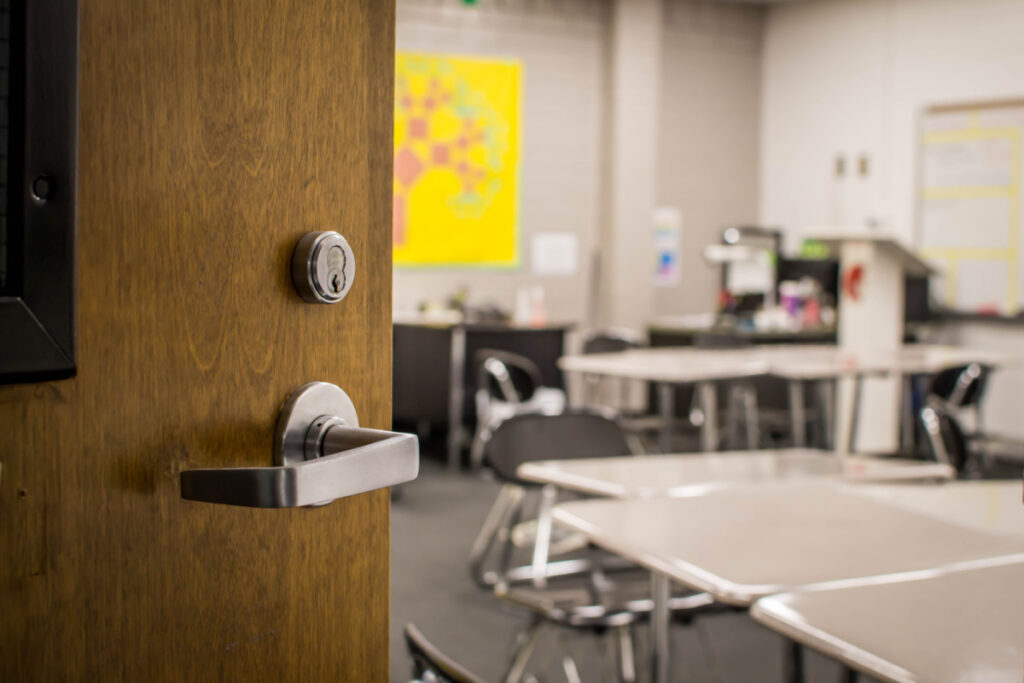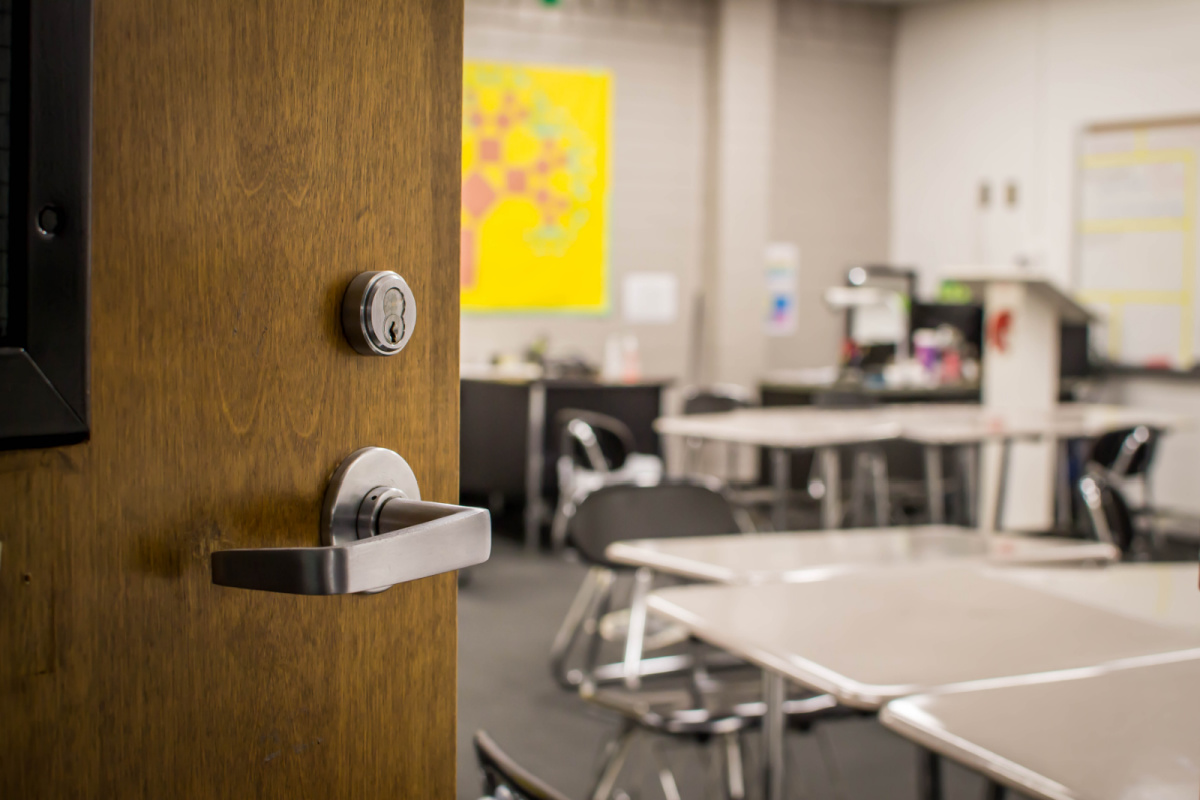
We are proud to share this guest post by Liza Gomez and John Martin, co-founders and co-CEOs of SAFEtech, offering school safety information for parents and caregivers.
The concern for school safety is at the top of every parent and caregiver’s mind. Every student deserves to attend a school that is invested in their safety with the proper knowledge and protocols in place to respond effectively to a crisis event. Likewise, educators should also feel secure in their understanding of the emergency procedures and should receive the proper training to confidently execute an emergency procedure during a time of crisis. At SAFEtech, we are working to develop school safety resources available to educators; in this blog post, we want to offer context and share information with families so that they can be advocates for safer schools.
Upgrades for School Safety
School safety takes many forms as schools are providing services that address both social and emotional needs on top of education services. Many schools started the new year with new structures built into the building to secure the physical space. This included checking all door locks, adding extra security features like fencing to close open campuses, and redirecting visitors to one main entrance that is further secured by cameras and lobbies separated by locked doors. Many districts have also added staff to specifically address safety needs. These new staff members are experienced in law enforcement or are former military with knowledge in providing security training.
Texas School Safety Center
In addition to building upgrades, schools have also been actively reviewing their existing emergency procedures to ensure they include the most up-to-date information. Texas schools rely on information from the Texas School Safety Center (TxSSC). The TxSSC is located at Texas State University and is tasked with key school safety initiatives and mandates by Chapter 37 of the Texas Education Code and Governor’s Homeland Security Strategic Plan. Using university-level research, the TxSSC trains and provides training to K–12 schools and builds partnerships with law enforcement.
The TxSSC has been responsible for three key initiatives, including:
- School Safety Readiness team
- Behavior Threat Assessment Program
- School-based law enforcement training
The TxSSC works year-round to meet the safety needs of schools to ensure schools are safe, secure, and healthy.
School Safety Cooperative at ESC-20
In addition to the TxSSC, Education Service Center, Region 20 (ESC-20) introduced a School Safety Cooperative for the 2022–2023 school year to provide professional development and technical assistance around safety initiatives for superintendents, campus administrators, and district law enforcement. As members, districts may attend school safety workshops at no cost or a reduced rate, may send unlimited participants to the workshops, and receive technical assistance at a reduced rate.
Examples of workshops include:
- Assessing Campus Climate and Culture to Improve Overall School Safety
- Virtual Like It or Not: Social Media and Mental Health
- Conducting the School Safety and Security Audit
Parents and Caregivers Advocating for Safer Schools
As schools actively review and improve their school safety procedures, there are ways for caregivers to proactively check the safety status of their child’s campus. Here are useful tips and questions for ensuring school safety:
What are the protocols for visitors accessing the campus?
- What are the access points?
- How are visitors checked in and identified while walking around campus?
How do students and families report suspicious activity?
- Encourage your child to report suspicious behaviors or threats to teachers, trusted staff on campus, or to you, their caregiver.
- If you receive the information, be sure to inform your child’s school with the necessary information. You can reach out to their teacher, counselor, or administration.
How often are emergency drills conducted on campus?
- What are emergency drills conducted for?
- What do the drills look like for students?
What type of training do teachers receive for emergency events and how frequently do trainings occur?
Is the school district a member of the ESC-20’s School Safety Collaborative?
Have new staff been added to specifically address school safety needs or are there plans to hire such staff?
How often are school safety audits conducted to ensure both state compliance and current safety needs for the campus?
Talk to your child frequently to get a pulse of the campus climate. If your child doesn’t feel safe, understand why, and talk to your campus staff to equip yourself with their safety standards to help your child learn how their teachers are working to keep students safe.
School Safety Should Be a Top Priority
Ultimately, every school has made school safety a priority issue, and as caregivers, we each have a role to ensure our children feel safe when they arrive on their campus. According to Abraham Maslow’s Hierarchy of Needs, only when physiological and safety needs are met, then students will feel loved, have higher self esteem, and reach self actualization. We cannot expect students to reach their full potential if they do not feel safe at school.
SAFEtech is proud to be an organization of experienced educators working to ensure schools have the most innovative technology to ensure students and staff are safe during emergency events. To learn more about SAFEtech, visit our website safetech.company and be sure to ask your school if they are a SAFEtech school.
Charter Moms Chats
Watch Liza Gomez and John Martin, co-founders and co-CEOs of SAFEtech, speak with Inga Cotton on Charter Moms Chats on December 8, 2022 at 4:00 PM Central live on Facebook and YouTube.
Liza Gomez is a co-founder and co-CEO of SAFEtech. Liza has over 9 years of teaching experience in K–12 public schools and a collective 13+ years in the education sector. She holds a B.A. from Connecticut College and M.S.Ed. in Education Entrepreneurship from the University of Pennsylvania. As the cofounder of SAFEtech, Liza is committed to creating safe learning spaces for students and educators to thrive.
John Martin is a co-founder and co-CEO of SAFEtech. John brings 14 years of working in Texas public schools as a teacher, counselor, and assistant principal. He received his B.A. from St. Mary’s University, M.Ed. from Our Lady of the Lake University, and M.S. Ed. from the University of Pennsylvania. John believes student accountability plays a vital role in campus safety.
Read More About School Safety
- “School safety grants expected in January,” Kimberly Reeves, Spectrum News 1, November 21, 2022
- “Texas spends millions on unproven school safety tool few use,” Talia Richman, Lauren McGaughy and Meghan Mangrum, Dallas Morning News, November 11, 2022
- “Panic buttons, automatic locks and bulletproof windows top the proposed safety rules after Uvalde shooting,” Brian Lopez, Texas Tribune, November 4, 2022
- “Geekdom Pre-Accelerator Program Mentors Startups to Success,” Iris Gonzalez, Startups San Antonio, October 14, 2022
- “Gov. Greg Abbott appoints first school safety chief four months after Uvalde shooting,” Trent Brown, Texas Tribune, October 3, 2022
- “Texas School Safety Center demonstrates intruder audits,” Jenni Lee, KVUE, August 31, 2022
- “Things to know as San Antonio kids head back to school,” Camille Phillips, Texas Public Radio, August 11, 2022
- “Texas safety officials will begin ‘random intruder detection audits’ of schools in September,” Kate McGee, Texas Tribune, July 1, 2022
- “After Uvalde shooting, Texas leaders will spend more than $100 million on school safety, mental health,” Patrick Svitek, Texas Tribune, June 28, 2022
- “Schools Are Spending Billions on High-Tech Defense for Mass Shootings,” Natasha Singer, New York Times, June 26, 2022
- “Fighting Cyberbullying in the Age of Distance Learning,” Maurine Molak, San Antonio Charter Moms, September 23, 2020
- “Can Technology Make Schools Safer?”, RAND Corporation, 2016
